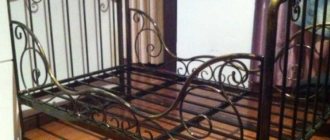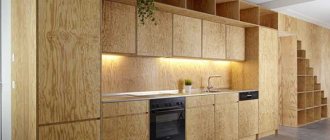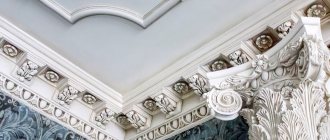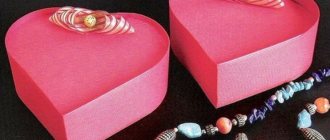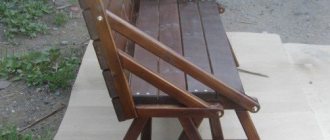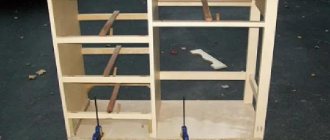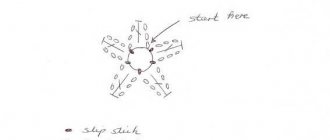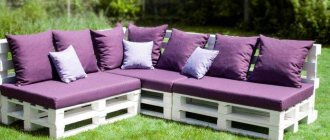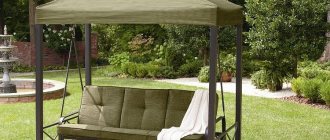The excellent physical characteristics of profile pipes make them a universal material for the manufacture of various structures. With a relatively low weight, they have high values of resistance to bending and compression, and excellently withstand constant and multidirectional variable forces. Profile pipes are much easier to weld and cut than traditional round pipes, and they also look more attractive. From such pipes you can make a comfortable and reliable bench, spending very little time and effort on the work.
Do-it-yourself benches from a profile pipe
Metal profile as a material for a bench
Benches made from metal pipes have several advantages:
- relatively light weight, in contrast to cast iron and concrete products, suitable only for parks;
- low cost and wide design possibilities, which cannot be said about structures made of stone;
- extraordinary strength, which distinguishes it from wooden benches that deteriorate under the influence of weather conditions, bugs and mold.
A significant disadvantage of the metal pipes used to create the bench is their unaesthetic appearance. However, you can ignore this drawback, because there are many ways to decorate a metal product. It is not for nothing that the most popular benches are those made from rust-resistant steel pipes and complemented with wooden elements. The seat is usually made from wood, so the bench does not heat up under the sun.
Gallery of benches made from profile pipes
Bench frame - metal, seat and back - wooden
The seat is made of boards laid vertically
The frame of the structure can only be made by a master
The back and seat are made of wide, painted boards
The product is decorated with forged elements and a drop-shaped back
Almost all elements of the bench, except the seat, are made of metal profiles
Armrests added to this product
The design resembles an open book
Bench dimensions and drawings
The characteristics of the design will depend primarily on the requirements of the master and the initial design. A profile pipe is often used to make all the metal elements of a future bench or bench. Wood or plastic is used to make seats and backs. The methods and types of fastenings used for the planks are thought out in advance, and the information is entered into the drawing. The ends will be cut at different angles, depending on the location of the remaining structural elements.
Before you begin making a bench, you should develop an accurate drawing or sketch. Thus, even before the start of the upcoming manipulations, you can calculate the amount of necessary materials and auxiliary elements.
When developing a sketch, you should consider the following points:
- the distance from the support strips to the bottom of the bench legs will be 45-50 cm;
- an acceptable and comfortable backrest height will be 50-55 cm;
- the supporting part of the bench will be 45-65 cm.
The bench can be without a back. Such an element is not easy to manufacture, but the level of comfort will increase significantly. Small benches can be easily built independently using the remains of a profile pipe. The design of the product can be traditional. Supporting the frame requires a minimum number of fasteners and material.
Drawing up drawings indicating dimensions
The manufacture of the bench begins only after the drawings are ready. Schematic images will help you decide on the type of bench and find out how much material is needed. To avoid mistakes when making a bench, dimensions are indicated in the drawings.
A metal bench without a back, the production of which takes little time, is created with supports - three rectangles, soldered together with two pipes - the seat frame. This design can be 2.3 m long, 60 cm wide and 45 cm high. If desired, a bench made of metal pipes can be made shorter, narrower or higher.
The bench with forged elements has a height of 880 mm
If you plan to make a bench with a back, then you will need a different drawing. A design with an element that allows the vacationer to tilt the body back requires much more effort to be put into the construction process. To build a bench with a back you will need a lot of materials. However, most often they make just such a convenient version of the bench.
Design options for metal benches
Before purchasing material and tools, you need to choose the structure of your future garden furniture. More precisely, you will need to choose a design for the supporting structure, make a metal frame for a bench with a wide seat, or try to assemble a more advanced option in the form of a park bench.
Both schemes are available for manufacture, you just need to choose the right material and method of assembling the frame of an iron bench or bench with your own hands:
- Simple furniture on a powerful steel frame without a back, such benches without sidewalls and back support are often used in the home or country house as a universal stand, therefore, with rare exceptions, they are built from a powerful square profile, with a cross-section of at least 30x30 mm;
- A traditional bench with a backrest can be made from steel strip, profile, or even wrought iron reinforcement. If you make an iron bench with your own hands, you will need to correctly assess your capabilities and skills, since, in addition to welding, you will have to master a bending machine, forging and cutting reinforcement.
The first ones turn out to be simple in design, so there are no special problems.
Bench made of metal strip and round pipe
In the second case, it makes sense to make metal benches with your own hands, photo, if you need a beautiful design and expressive style of courtyard furniture.
Benches made of forged strip and reinforcement
Selection of construction raw materials
The main material required for the manufacture of a metal bench is profile pipes. They can have any shape, but the bench frame is best made from profiles with a square or rectangular cross-section. Pipes with flat outlines can be easily connected to any parts. It is desirable that metal profiles be cast from carbon or low-alloy steel - the most durable raw materials.
Square pipes are a suitable material for creating a bench.
In addition to pipes, the materials for creating a bench are:
- timber beams with dimensions 50x80 mm, from which the back and seat are constructed;
- screws having a diameter of 7 +/- 1 mm and a length of about 10 cm;
- self-tapping screws fixing wooden elements;
- enamel and primer that protect metal products from rusting;
- antiseptic composition;
- finishing agent for wood and metal (for example, varnish and paint).
Bench protective covering
Metal and wood are processed separately, using different materials and technologies. The primer is used to protect the frame. Red lead is recommended by experts as a material that will protect metal elements from possible corrosion over the next several years. When calculating the established period, the regular exposure of the bench to heavy rains and snowfalls is also taken into account. In other words, we are talking about a stationary model.
Wooden elements can be painted. Preliminary use of drying oil will protect the product from the negative effects of the environment and sudden temperature changes that often occur during the summer. The design concept and color palette must be in harmony. It is recommended to emphasize the natural depth of the wood used by varnishing.
Calculation of the quantity of materials
Usually, the production of a medium-sized bench takes at least 11 m of profile pipe with a cross-section of 30×30 mm, because to create a bench without a back you need the following parts:
- 6 pieces of profile 60 cm long (long elements of rectangular supports);
- 6 pieces of 45 cm each (short fragments of the structure);
- 2 blanks of 2.3 m each (frames for the seat and fastening the supports).
Making a bench requires a minimum of materials
In addition to metal parts, when creating a bench without a back, you will need wooden blanks:
- 8 rectangular bars 6 cm wide;
- bolts with a flat round head and nuts (16 pieces each).
If you want to make a bench with a back, you will need to purchase 25 mm and 30 mm thick boards and at least 8 m of profile pipes with a cross-section of 25×25 mm from a hardware store.
A pipe is a material for cutting fragments of the skeleton of a bench, that is, the following parts:
- crossbar located between the supports and equal to 1.55 m;
- 2 pieces 35 cm long, from which the base of the seat is created;
- 2 bent parts with a height of 78 cm and a bending span of 10 cm, necessary to create the back and rear fragments of supports;
- 2 metal parts 39 cm long - pieces for the front supports;
- 2 pieces of 20 cm each, serving as clamps for supports located in front;
- 4 support heels measuring 40x40 mm - ordinary metal plates;
- 2 bent metal strips 45 cm long, which solder the supports on both sides.
To create this version of the bench you need a lot of materials
The following materials will be needed to create a bench seat with a back:
- 3 boards 1.6 m long, 60 mm wide and 25 mm thick;
- 3 wooden blanks 1.6 m long, 60 mm wide and 30 mm thick;
- nuts and bolts with a round head (24 pieces each).
The process of making a wooden bench
The design of the bench in question corresponds to the following dimensions: back and seat lengths – 1500 mm, seat width – 500 mm, backrest angle of about 20 degrees.
What materials and tools will be needed?
- Boards, bars.
- Antiseptic and varnish.
- Sandpaper.
- Self-tapping screws.
- Plane.
- Hacksaw.
Assembly instructions
- Using a hacksaw, the board blanks are cut to the required length. To do this, you can use 6 strips with a length of 1500 mm and a width of 140 mm.
- Using a plane and sandpaper, the workpieces are given the required surface smoothness, including the side edges. They are then soaked in antiseptic and left to dry.
- Two backrest holders with a leg 720 mm long and 140 mm wide are prepared. A cut is made from the middle of these holders at an angle of 20 degrees, which is then polished.
- The bench support pairs are connected using bars and screws. It is advisable to deepen the screws into the wood using preliminary drilling, which will reduce the influence of corrosive processes.
- The seat of the bench is assembled, which will require 3 planks 1500 mm long, and a backrest made of two of the same planks.
- To give additional rigidity, the legs are connected from below with a board.
- The bench is varnished or oil paint is used instead.
Tools
To make a bench from profile pipes, it is customary to arm yourself with several tools:
- an angle grinder equipped with wheels for cutting and sharpening;
- electric drill with drills of different diameters;
- a welding machine with electrodes with a diameter of at least 3 mm, which will allow you to easily solder metal parts with a thickness of more than 2 mm;
- hammer;
- electric jigsaw;
- a machine sanding wood with sandpaper;
- measuring tape;
- a marker to make notes;
- core
If you plan to create a bench from curved pipes, you will need a pipe bender. In addition to it, you will need a template of a rounded metal profile made from a piece of plywood - a tool that allows you to control the bending of paired parts.
Additional design elements
In addition to the bench, a small table can add convenience. For its manufacture, scrap materials can also be used. You will need:
- wood;
- plastic;
- pieces of glass;
- metal.
There are situations when a bench is almost the only decorative element of the entire site. However, in this case, it is recommended to make the central part of the recreation area out of the structure. If there is a pond, the bench should be placed in close proximity to it. A flower bed, blooming garden or fountain would be a great place to install a bench. To arrange a summer cottage, it is not at all necessary to buy expensive garden furniture, because everything you need can be done with your own hands.
Do-it-yourself bench from a profile pipe: step-by-step instructions, drawings, photos, videos
dacha garden DIY bench Plot
Guide to building a bench from profile pipes
A bench without a back is a simple structure that is created in stages:
- The supporting elements of the structure are welded to each other, with short sections placed vertically and long sections horizontally. When working with a welding machine, only right angles are created between the supports;
- The welding seams made are smoothed with a grinding machine and primed with a special compound;
- Pipes serving as a frame are welded to the supports, after which the resulting seams are polished;
- In the frame profiles, 8 holes are made with a drill - holes for fastening elements that will connect the metal frame with the wooden beams of the seat;
The frame of the bench is welded and the bars are bolted - The metal structure is coated with paint that protects against corrosion;
- Wood materials are treated with stain or varnished and attached to a metal frame.
The wood is painted and fixed to the frame, and the legs of the structure are made comfortable
If the seat is intended to be made of metal, then rectangular pipes are used instead of bars. They are welded to the skeleton of the structure and treated with a coloring emulsion.
Other actions are performed when making a bench with a back:
- The crossbar is connected by welding to two pipes 35 cm long. The pole, fixed between the two supports, is placed perpendicularly. It should be in the middle of both sections of profiles;
- Bent pipe segments 78 cm long are attached to the metal structure. According to the rules, welding seams are created in places where the profiles bend;
- The frame is supplemented with the front parts of the support, while the soldering point for the base of the seat and the supporting elements is made at a place 9 cm away from their front zone;
- The structure is strengthened by connecting the crossbar with profiles that serve as front supports;
- 2 arc-shaped pipes are welded between the supports, after which pads are soldered to the edges of the legs;
- The areas that have been welded are sanded with a machine, and all frame parts are coated with a primer. After it dries, anti-corrosion paint is applied to the metal surface;
- Boards are placed on the metal frame. The back of the bench is created from thin wooden elements, and the seat from thick wooden elements. The boards are attached to the frame with bolts.
The structure is made of 6 profiles and 5 boards
Wanting to make the bench comfortable and original, armrests are attached to it. They are 2 pipes of 75 cm each, bent with a special tool. The armrests are welded to the seat frame.
Preparing the boards
Depending on the quality of the lumber, it is prepared. First, use sandpaper to round all the corners. You just need to carry out this stage without fanaticism, the rounding radius is 1-2 mm. You don’t have to measure the amount of rounding, but simply check it with your own hands by touch.
Treating wooden boards with stain
The next point is stain treatment. This is a more decorative part than a functional one. This operation will highlight the structure of the tree. If there is no stain, then you can get by with a strong solution of potassium permanganate.
Before processing wood, check the strength of the solution on the back or end side of the board. It is necessary to make such a concentration that the wood darkens, but does not turn black.
If, after covering with stain, the wood has acquired a too dark color, then the surface of the boards can be lightly sanded with fine sandpaper.
In each wooden element of the bench, three holes with a diameter of 6 mm are drilled. To make all the holes for the bolts symmetrical, you can stack the boards, one on top of the other.
All holes are located in the middle of the board. The first and third are 2 cm from the edge, and the second is strictly in the middle. To check, place the boards on the frame of the future bench and check the accuracy of the markings.
Finished holes must be countersunk. The depth of the countersinks is selected so that the countersunk heads of the bolts are flush in them.
Recommendations for decorating the product
The easiest way to decorate a bench made of profile pipes is to cover it with paint. To do this, you can use not only standard black paint. It all depends on wishes and possibilities. An additional decoration for a metal bench can be climbing plants planted around it, for example, grapes.
If it is assumed that the bench will be an element of the recreation area, then next to it you need to place a table made of plastic or wood. It is recommended to place the bench itself near a pond, fountain or flower bed. A good design option for a metal bench is to create and locate it near a structure made from hedge profiles.
This structure remains to be covered with polycarbonate
When creating a bench for a children's corner, you should place a swing or a sandbox nearby. If adults need a bench, then it should be placed in a gazebo or covered with a canopy. It is recommended to lay a blanket on the seat, which will make the metal bench soft. In addition to the bench, you can place a table and barbecue in the recreation room.
Decorating a bench
In order to decorate a bench made from a profile pipe, significant costs will not be required. It is enough to turn on your own imagination and use the materials that are available. If there is no special desire to do anything significant, then you can paint the finished bench in different colors. The general concept of the summer cottage should also be taken into account, so you can create a truly harmonious ensemble. Tables made in the same style can complement the overall picture.
There are many interesting design solutions for creating benches from profile pipes. A skillful combination of different materials can lead to very unexpected design solutions. In order to improve (decorate) an already made bench, you can use the following concepts:
- remains of ceramic tiles, broken glass, pebbles;
- forged patterns.
The bench can also be used as a small table. For this, design elements such as:
- carved elements and patterns;
- elements decorated by burning;
- various decorative elements and wire structures.
To give wooden elements a special shade, you will need varnish, which is applied to a surface previously treated with stain. For the recreation area, you can use bright and unusual colors that will only decorate the product.
There are several burning technologies based on the material used:
- Pyrotype. Applying a pattern by stamping using a certain temperature regime.
- Pyrography. A hot pencil is used. The ornament is drawn manually. Such offers should be considered when purchasing a finished product from the factory. Custom designs are expensive.
One of the simplest and at the same time effective ways to decorate a finished bench is to use bas-reliefs, rosettes, layouts, corners and other elements that can create a single composition. The materials used can be composite, metal or wood. A unique design is created by using different textures.
